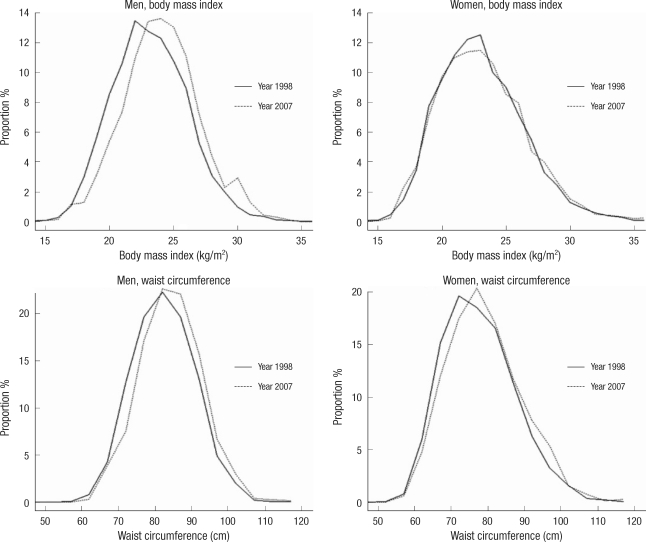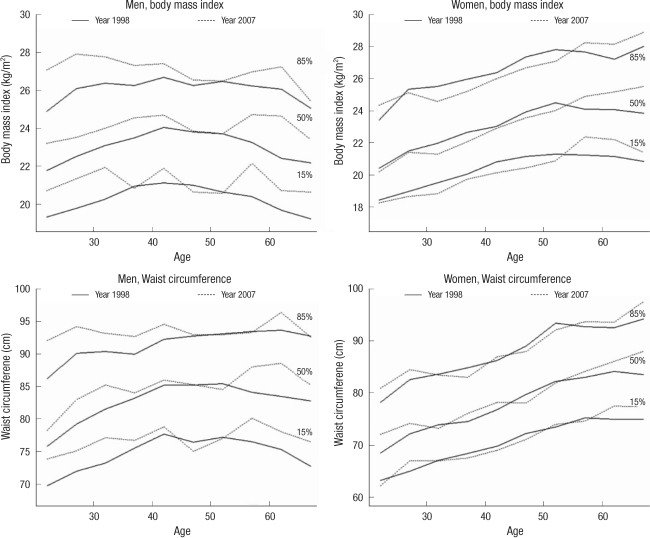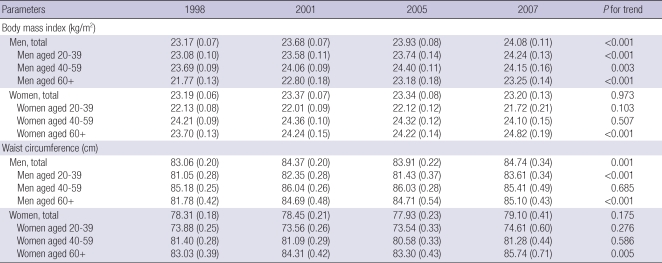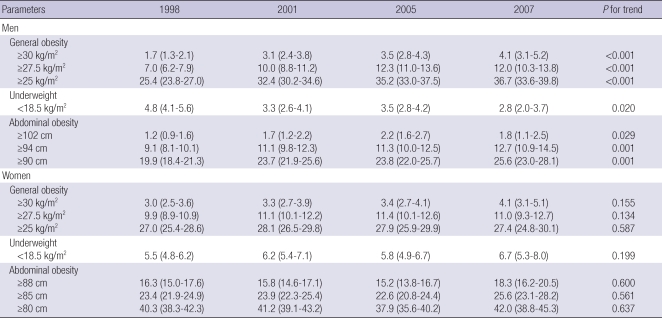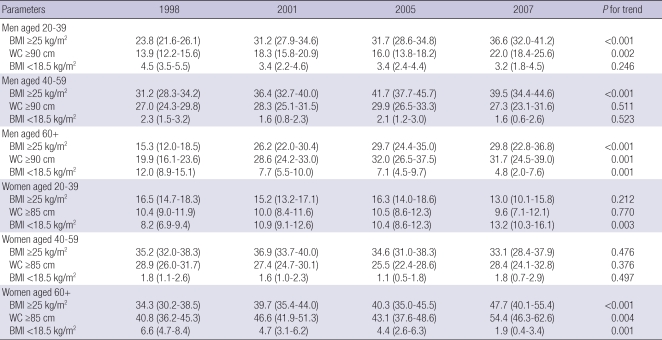Abstract
We examined trends in obesity among Korean adults, using body mass index (BMI) and waist circumference (WC) as reported in national surveys. Data (10,043 men and 12,758 non-pregnant women) were derived from four waves of the Korea National Health and Nutrition Examination Survey conducted in 1998, 2001, 2005, and 2007. Between 1998 and 2007, the distribution of BMI and WC showed shifts toward the right among men. Mean values of BMI and WC and the corresponding overweight (includes obesity) and obesity prevalences showed increasing trends in men but not in women. Women aged 60+ showed significant increases in obesity measures, including mean BMI and WC, and the associated prevalences. Among women aged 20-39, the prevalence of underweight increased significantly between 1998 and 2007, and BMI showed a decreasing tendency. These time trends in young women were the reverse of the trends in young men. In conclusion, policy efforts to abate overweight and obesity trends need to be exercised among men and older women. In addition, more national studies regarding potential increases in underweight among young women are warranted.
Keywords: Asia, Body Mass Index, Korea, Obesity, Overweight, Thinness, Waist Circumference
INTRODUCTION
An increase in the prevalence of overweight and obesity has become a global public health concern (1). Based on the USA National Health Interview Survey (NHIS) and the National Health and Nutrition Examination Survey (NHANES), adulthood overweight (body mass index, BMI ≥25 kg/m2) and obesity (BMI ≥30 kg/m2) became highly prevalent during the past decades, reaching 66.3% and 32.2% respectively, in adults aged 20+ in 2003-2004 (2). A rise in abdominal obesity as measured by waist circumference (WC) has also been reported in the USA (3). Age-adjusted, mean WC increased from 96.0 cm to 100.4 cm in men and from 89.0 cm to 94.0 cm in women between an initial measurement within 1988-1994 and a later measurement in 2003-2004 (3). Despite the long-term upsurge in obesity measures, patterns in obesity trends vary among time periods and population subgroups. There has been no increase in the prevalences of overweight and obesity among women in the USA since 2000 (4), and the increase in WC among women in the USA since 1999 has not been significant (3). A Canadian study in which eight Canadian surveys between 1953 and 1998 were used to describe changes in BMI showed that the distribution of BMI has shifted to the right since 1970-1972, especially among men (5). Several studies in East Asian countries, including China and Japan, have examined obesity trends based on BMI information and have shown gender and age group differences (6-9). Several reports in Korea have been published on obesity trends, but they have only used limited rounds of Korea NHANES (K-NHANES) data (10, 11). Studies examining trends in BMI and WC simultaneously are scarce. This study examined trends in obesity measures using anthropometric data (BMI and WC) from K-NHANES data collected in 1998, 2001, 2005, and 2007.
MATERIALS AND METHODS
Study subjects
We obtained data from four waves of the K-NHANES conducted in 1998, 2001, 2005, and 2007 by the Ministry of Health and Welfare of Korea. Information was collected from stratified, multistage probability samples of Korean households representing the civilian, non-institutionalized population. The response rates for the K-NHANES were between a low of 65.8% in 2007 and a high of 86.5% in 1998. Additional details regarding study design and methods are provided elsewhere (12). The K-NHANES includes a health examination survey for each participant, from which the anthropometric data were derived. A total of 22,995 men and women aged 20+ (7,962 in 1998, 6,572 in 2001, 5,464 in 2005, and 2,997 in 2007) participated in the health examination survey. Of these, we identified 194 pregnant women (69 in 1998, 57 in 2001, 41 in 2005, and 27 in 2007) and excluded them as study subjects.
Anthropometric measurement
BMI (the weight in kilograms divided by square of the height in meters) and WC were used as obesity measures in this study. Although they were conducted in four different years, the same protocols and anthropometric measurement instruments were used for all four waves of the K-NHANES (12). Body weight was measured to the nearest 0.1 kg on a calibrated balance-beam scale while the participants wore a lightweight gown or underwear. Height was measured to the nearest 0.1 cm in the upright position using a stadiometer. WC was measured to the nearest 0.1 cm at the midpoint between the bottom of the rib cage and the top of the lateral border of the iliac crest during minimal respiration.
Criteria for overweight, obesity, and underweight
Based on BMI, general overweight (includes obesity, BMI ≥25 kg/m2) and general obesity (BMI ≥30 kg/m2) criteria for adults as defined by the World Health Organization (WHO) (1) and the US National Institute of Health (13) were employed. In this study, the prevalence of overweight includes the prevalence of obesity. We also used 27.5 kg/m2 as an additional cut-off for general obesity. In a prior report from a WHO expert consultation, the cut-off point of 27.5 kg/m2 was added as a point for public health action (14). For underweight, we used the BMI cut-off for underweight as defined by the WHO (BMI <18.5 kg/m2) (1).
For abdominal obesity, we used three different WC cut-off points each for men and women: 102 cm, 94 cm, and 90 cm for men, and 88 cm, 85 cm, and 80 cm for women. Two different levels of WC (102 cm and 94 cm for men and 88 cm and 80 cm for women) for European adults have been suggested as indicators of increased risks for metabolic complications (1). A recent joint statement on the definition of the metabolic syndrome suggested the use of national and regional cut-offs for WC (15). The Korean Society for the Study of Obesity (KSSO) proposed 90 cm for men and 85 cm for women as the appropriate WC cut-offs for Koreans (16).
Statistical analysis
Using the R statistical programming language, we presented figures for the distribution of BMI and WC by year, which reveals shifts in obesity measures (Fig. 1). In addition, we employed quantile regression analysis (17) with the R quantreg package to describe age-specific time trends in obesity measures (Fig. 2). Quantile regression is a type of regression analysis that approximates either the median or other quantiles of continuous variables. This quantile regression analysis can allow us to examine time trends of certain percentile points as well as median values in the BMI and WC distribution. In this study, we presented the age-specific changes at the 15th, 50th, and 85th percentiles. Using SAS (SAS Institute Inc., Cary, NC, USA), we also presented changes in the age-adjusted least square mean and standard error of obesity measures and P values for time trends, using regression analysis (PROC SURVEYREG in SAS) after taking account of primary sampling units, stratification, and sample weights for K-NHANES. To present changes in the age-adjusted prevalence of underweight, overweight (includes obesity), and obesity, we employed the direct standardization method with the 2005 Korean Census population as the standard population. Sample weights from the K-NHANES were also considered in this standardization. We used logistic regression (PROC SURVEYLOGISTIC in SAS) to test time trends of the age-adjusted prevalences after taking account of primary sampling units, stratification, and sample weights from the K-NHANES.
Fig. 1.
Changes in the distribution of body mass index (kg/m2) and waist circumference (cm) between 1998 and 2007 Korea National Health and Nutrition Examination Survey data among men and women aged 20+.
Fig. 2.
Estimated 85th percentiles, 50th percentiles (medians) and 15th percentiles of body mass index (kg/m2) and waist circumference (cm) by age among men and women aged 20+ who participated in 1998 and 2007 Korea Health and Nutrition Examination Survey: Results of quantile regression analysis.
RESULTS
Table 1 shows the number of study subjects by survey year, gender and age group. A total of 22,801 subjects (10,043 men and 12,758 non-pregnant women) participated in four waves of the K-NHANES. Table 1 also presents the increase in the proportion of the elderly population by year.
Table 1.
Number (percentage) of study subjects by survey year, gender and age group
Data were from 1998, 2001, 2005, and 2007 Korea National Health and Nutrition Examination Survey (22,801 men and women aged 20+).
Fig. 1 reveals changes in the distribution of BMI and WC between 1998 and 2007 among men and women aged 20+. Male BMI shifted to the right year by year whereas female BMI did not. When we include data for the 2001 and 2005 K-NHANES simultaneously, a graded pattern of shift to the right was found in men. Shifts to the right in the distribution of WC between 1998 and 2007 were found in both genders, but the shift in women was less evident than men. When we compared data from the 2001 and 2005 K-NHANES with data from the 1998 K-NHANES, a shift to the right was not found among women (data not shown here).
Fig. 2 shows the results of the quantile regression analysis with which we approximated the 85th, 50th, and 15th percentiles of BMI and WC by age among men and women. We found gender differences in the relationship between age and two obesity measures. A linearly rising trend of BMI and WC with age was found among women, but the relationship between age and obesity measures among men was rather convex or flat. We also found a gender difference in the changes in BMI and WC between years. In younger and older men, the 15th, 50th, and 85th percentiles of obesity measures in 2007 were greater than those in 1998, while in middle aged men those percentiles remained similar. However, increased 15th, 50th, and 85th percentiles were only detected among older women, while similar percentiles in obesity measures were noticed in younger age groups.
Table 2 shows age-specific time trends in least squares means and their standard errors for BMI and WC between 1998 and 2007 among Korean men and women aged 20+. In men, BMI and WC increased year by year (all P for trend <0.001), while in women no significant increases in either obesity measure was detected. However, time trends varied with age group. While no significant changes in BMI and WC were found among women aged 20-39 and 40-59, significant increases were detected in women aged 60+ (all P for trend <0.01). BMI in women aged 20-39 showed a decreasing tendency between 1998 and 2007, which did not reach significant levels (P for trend=0.103).
Table 2.
Trends in least square mean (±standard error) values for body mass index and waist circumference
Data were from 1998, 2001, 2005, and 2007 Korea National Health and Nutrition Examination Survey (K-NHANES) (10,043 men and 12,758 women aged 20+). Regression analyses were employed to estimate age-adjusted least square means (standard errors) of obesity measures and to test time trends of the means, after taking account of primary sampling units, stratification, and sample weights from the K-NHANES.
Table 3 presents trends in age-standardized prevalence of overweight (includes obesity), obesity, and underweight among men and women aged 20+. In men, statistically significant increases in the prevalence of overweight and obesity based on BMI were found. For example, the prevalence of BMI of 30 kg/m2 or over was 1.7% in 1998, but increased more than twofold (4.1%) by 2007 (P for trend <0.001). Abdominal obesity in men showed statistically significant increases (for all criteria of ≥102 cm, ≥94 cm, and ≥90 cm). Meanwhile, the age-adjusted prevalence of underweight measured by BMI below 18.5 kg/m2 decreased from 4.8% in 1998 to 2.8% in 2007 among men aged 20+ (P for trend=0.020). In women, however, no significant time trends between 1998 and 2007 were found. Unlike in men, an increase in underweight (BMI <18.5 kg/m2) was found in women.
Table 3.
Trends in age-standardized prevalence (95% confidence intervals) of overweight (includes obesity), obesity, and underweight
Data were from 1998, 2001, 2005, and 2007 Korea National Health and Nutrition Examination Survey (K-NHANES) (10,043 men and 12,758 women aged 20+). The 2005 Korean Census population was used as the standard population and sample weights from the K-NHANES were considered in the direct standardization. Logistic regression analyses were employed to test time trends of the age-adjusted prevalences, after taking account of primary sampling units, stratification, and sample weights from the K-NHANES.
Table 4 indicates trends in age-standardized prevalence of general overweight (includes obesity, BMI ≥25 kg/m2), abdominal obesity (using the KSSO criteria: men ≥90 cm, women ≥ 85 cm), and underweight (BMI <18.5 kg/m2) by age groups. The prevalence of general overweight significantly increased with year in all age groups of men (P for trend <0.001). The prevalence of abdominal obesity showed increasing trends in younger (ages 20-39) and older (ages 60+) age groups. Meanwhile, general overweight and abdominal obesity did not increase with year among women aged 20-39 and 40-59, but both showed definite increases among women aged 60+ (all P for trend <0.01). Gender differences in underweight trends were found in those aged 20-39. The prevalence of underweight showed a decreasing tendency from 4.5% in 1998 to 3.2% in 2007 (P for trend=0.246) among 20- to 39-yr-old men, but significantly increased with year in the same age group of women (P for trend=0.003). No gender differences in underweight trends were detected in other age groups. In men and women, no significant changes in underweight trends were found in those aged 40-59, and increasing trends were detected in those aged 60+.
Table 4.
Age-specific trends in age-standardized prevalence (95% confidence intervals) of overweight (includes obesity) and underweight
Data were from 1998, 2001, 2005, and 2007 Korea National Health and Nutrition Examination Survey (K-NHANES) (10,043 men and 12,758 women aged 20+). BMI refers body mass index and WC refers waist circumference. The 2005 Korean Census population was used as the standard population and sample weights from the K-NHANES were considered in the direct standardization. Logistic regression analyses were employed to test time trends of the age-adjusted prevalences, after taking account of primary sampling units, stratification, and sample weights from the K-NHANES.
DISCUSSION
The results of this study showed gender differences in obesity trends. Clear increasing trends in obesity measures (BMI and WC) and associated overweight and obesity prevalences were found among men, but not among women. The distribution of BMI and WC showed shifts toward the right among men between 1998 and 2007. Mean values of BMI and WC and the corresponding prevalence of overweight and obesity showed increasing trends in men, but not in women. Age group differences in obesity measures were also detected. While no significant changes in both mean WC and the prevalence of abdominal obesity were found among men aged 40-59, women aged 60+ showed significant increases in multiple obesity measures, including mean BMI and WC and associated prevalences.
Gender and age group differences in obesity trends have also been reported in East Asian countries. In previous Korean studies using the 1998 and 2001 K-NHANES, an increase in the prevalence of overweight was not evident in women (10, 11). In a prior Japanese study in which National Nutrition Survey data between 1976 and 1995 were used, male BMI, overweight, and obesity showed rising trends, but female BMI decreased and there were no significant changes in the prevalence of female overweight and obesity (9). Matsushita and colleagues showed a relatively greater increase in male BMI among younger age cohorts than older age cohorts, but the findings among women were the reverse (6). In a Chinese study using National Health and Nutrition Survey data between 1989 and 2000 (7), a relatively greater increase in overweight and obesity was found among men than women and no increase in BMI among women aged less than 35 was found. Another Chinese study conducted in Tianjin compared BMI between 1989 and 1996 and found decreasing female BMI (18).
The results of this study showed an increase in underweight among women aged 20-39. Among this same group, the prevalence of underweight increased significantly between 1998 and 2007, and BMI showed a decreasing tendency. These time trends in young women were the reverse of time trends in young men. According to a Korean study, underweight in adult women was associated with increased mortality, especially from respiratory diseases (19). Underweight in pregnant women may result in obstetric complications (20, 21), while other recent studies of the impact of maternal underweight on obstetric performance showed different results (22, 23). One explanation for the increased prevalence of underweight among young women might be related to young Korean women's engagement in losing weight. According to the recent International Health Behavior Survey of university students in 22 countries, awareness of overweight and attempts to lose weight were highest in Asian countries where body weights are generally low (24). Furthermore, the proportion of respondents 'trying to lose weight' was highest in Korean female university students (24). Another potential explanation would be related to decreased participation rates in K-NHANES during the past decade. The participation rates in K-NHANES have declined steadily since 1998 (86.5% in 1998, 77.3% in 2001, 70.2 % in 2005, and 65.8% in 2007). Survey non-participants especially among young women are likely to be more overweight due to the raised sensitivity about overweight and obesity in the recent decade (25, 26). Participation rates in K-NHANES might have disproportionately decreased especially among young women with high BMI, resulting in relative increases in underweight prevalence in the subgroup analyses.
This study has a limitation. Overweight and obesity trends before 1998 were not explored in our study since the 1998 K-NHANES was the first national survey containing the information on measured anthropometric data for representative Koreans. This study, however, has several strengths. First, we examined trends in BMI and WC simultaneously. Second, we used multiple waves of nationally representative samples and took into account of primary sampling units, stratification, and sample weights from the K-NHANES in our analyses.
The results of our study have important policy implications. First, given the ongoing trend of increasing BMI and WC and associated obesity measures in men, policy efforts to abate overweight and obesity trends among men seems especially important. Second, for women, attention to the increase in overweight and obesity problems among the elderly needs to be prioritized. Third, aside from policy efforts to address the overweight and obesity problems, more national studies regarding potential increases in underweight among young women are warranted.
ACKNOWLEDGMENTS
We thank the Korea Centers for Disease Control and Prevention for providing the data.
References
- 1.World Health Organization. Obesity: Preventing and Managing the Global Epidemic: Report on a WHO Consultation (WHO Technical Report Series 894) Geneva, Switzerland: World Health Organization; 2000. [PubMed] [Google Scholar]
- 2.Ogden CL, Carroll MD, Curtin LR, McDowell MA, Tabak CJ, Flegal KM. Prevalence of overweight and obesity in the United States, 1999-2004. JAMA. 2006;295:1549–1555. doi: 10.1001/jama.295.13.1549. [DOI] [PubMed] [Google Scholar]
- 3.Li C, Ford ES, McGuire LC, Mokdad AH. Increasing trends in waist circumference and abdominal obesity among US adults. Obesity (Silver Spring) 2007;15:216–224. doi: 10.1038/oby.2007.505. [DOI] [PubMed] [Google Scholar]
- 4.Prevalence of Overweight, Obesity and Extreme Obesity among Adults: United States, Trends 1960-62 through 2005-2006. National Center for Health Statistics. [accessed on 20 October 2009]. Available at http://origin.cdc.gov/nchs/data/hestat/overweight/overweight_adult.htm.
- 5.Katzmarzyk PT. The Canadian obesity epidemic: an historical perspective. Obes Res. 2002;10:666–674. doi: 10.1038/oby.2002.90. [DOI] [PubMed] [Google Scholar]
- 6.Matsushita Y, Yoshiike N, Kaneda F, Yoshita K, Takimoto H. Trends in childhood obesity in Japan over the last 25 years from the national nutrition survey. Obes Res. 2004;12:205–214. doi: 10.1038/oby.2004.27. [DOI] [PubMed] [Google Scholar]
- 7.Wang H, Du S, Zhai F, Popkin BM. Trends in the distribution of body mass index among Chinese adults, aged 20-45 years (1989-2000) Int J Obes (Lond) 2007;31:272–278. doi: 10.1038/sj.ijo.0803416. [DOI] [PubMed] [Google Scholar]
- 8.Wildman RP, Gu D, Muntner P, Wu X, Reynolds K, Duan X, Chen CS, Huang G, Bazzano LA, He J. Trends in overweight and obesity in Chinese adults: between 1991 and 1999-2000. Obesity (Silver Spring) 2008;16:1448–1453. doi: 10.1038/oby.2008.208. [DOI] [PubMed] [Google Scholar]
- 9.Yoshiike N, Seino F, Tajima S, Arai Y, Kawano M, Furuhata T, Inoue S. Twenty-year changes in the prevalence of overweight in Japanese adults: the National Nutrition Survey 1976-95. Obes Rev. 2002;3:183–190. doi: 10.1046/j.1467-789x.2002.00070.x. [DOI] [PubMed] [Google Scholar]
- 10.Kim DM, Ahn CW, Nam SY. Prevalence of obesity in Korea. Obes Rev. 2005;6:117–121. doi: 10.1111/j.1467-789X.2005.00173.x. [DOI] [PubMed] [Google Scholar]
- 11.Park HS, Park CY, Oh SW, Yoo HJ. Prevalence of obesity and metabolic syndrome in Korean adults. Obes Rev. 2008;9:104–107. doi: 10.1111/j.1467-789X.2007.00421.x. [DOI] [PubMed] [Google Scholar]
- 12.Korea National Health and Nutrition Examination Survey. KCDC (Korea Center for Disease Control and Prevention) [accessed on 20 October 2009]. Available at http://knhanes.cdc.go.kr/
- 13.National Institute of Health. Clinical guidelines on the identification, evaluation, and treatment of overweight and obesity in adults. The evidence report. National Institute of Health. Obes Res. 1998;6(Suppl 2):51S–209S. [PubMed] [Google Scholar]
- 14.WHO Expert Consultation. Appropriate body-mass index for Asian populations and its implications for policy and intervention strategies. Lancet. 2004;363:157–163. doi: 10.1016/S0140-6736(03)15268-3. [DOI] [PubMed] [Google Scholar]
- 15.Alberti KG, Eckel RH, Grundy SM, Zimmet PZ, Cleeman JI, Donato KA, Fruchart JC, James WP, Loria CM, Smith SC, Jr International Diabetes Federation Task Force on Epidemiology and Prevention; National Heart, Lung, and Blood Institute; American Heart Association; World Heart Federation; International Atherosclerosis Society; International Association for the Study of Obesity. Harmonizing the metabolic syndrome: a joint interim statement of the International Diabetes Federation Task Force on Epidemiology and Prevention; National Heart, Lung, and Blood Institute; American Heart Association; World Heart Federation; International Atherosclerosis Society; and International Association for the Study of Obesity. Circulation. 2009;120:1640–1645. doi: 10.1161/CIRCULATIONAHA.109.192644. [DOI] [PubMed] [Google Scholar]
- 16.Lee SY, Park HS, Kim DJ, Han JH, Kim SM, Cho GJ, Kim DY, Kwon HS, Kim SR, Lee CB, Oh SJ, Park CY, Yoo HJ. Appropriate waist circumference cutoff points for central obesity in Korean adults. Diabetes Res Clin Pract. 2007;75:72–80. doi: 10.1016/j.diabres.2006.04.013. [DOI] [PubMed] [Google Scholar]
- 17.Koenker R. Quantile Regression. New York: Cambridge University Press; 2005. [Google Scholar]
- 18.Yu Z, Nissinen A, Vartiainen E, Song G, Guo Z, Tian H. Changes in cardiovascular risk factors in different socioeconomic groups: seven year trends in a Chinese urban population. J Epidemiol Community Health. 2000;54:692–696. doi: 10.1136/jech.54.9.692. [DOI] [PMC free article] [PubMed] [Google Scholar]
- 19.Jee SH, Sull JW, Park J, Lee SY, Ohrr H, Guallar E, Samet JM. Body-mass index and mortality in Korean men and women. N Engl J Med. 2006;355:779–787. doi: 10.1056/NEJMoa054017. [DOI] [PubMed] [Google Scholar]
- 20.Naeye RL. Maternal body weight and pregnancy outcome. Am J Clin Nutr. 1990;52:273–279. doi: 10.1093/ajcn/52.2.273. [DOI] [PubMed] [Google Scholar]
- 21.Spinillo A, Capuzzo E, Piazzi G, Ferrari A, Morales V, Di Mario M. Risk for spontaneous preterm delivery by combined body mass index and gestational weight gain patterns. Acta Obstet Gynecol Scand. 1998;77:32–36. [PubMed] [Google Scholar]
- 22.Bhattacharya S, Campbell DM, Liston WA, Bhattacharya S. Effect of body mass index on pregnancy outcomes in nulliparous women delivering singleton babies. BMC Public Health. 2007;7:168. doi: 10.1186/1471-2458-7-168. [DOI] [PMC free article] [PubMed] [Google Scholar]
- 23.Sebire NJ, Jolly M, Harris J, Regan L, Robinson S. Is maternal underweight really a risk factor for adverse pregnancy outcome? A population based study in London. BJOG. 2001;108:61–66. doi: 10.1111/j.1471-0528.2001.00021.x. [DOI] [PubMed] [Google Scholar]
- 24.Wardle J, Haase AM, Steptoe A. Body image and weight control in young adults: international comparisons in university students from 22 countries. Int J Obes (Lond) 2006;30:644–651. doi: 10.1038/sj.ijo.0803050. [DOI] [PubMed] [Google Scholar]
- 25.Stamatakis E, Wardle J, Cole TJ. Childhood obesity and overweight prevalence trends in England: evidence for growing socioeconomic disparities. Int J Obes (Lond) 2010;34:41–47. doi: 10.1038/ijo.2009.217. [DOI] [PMC free article] [PubMed] [Google Scholar]
- 26.Khang YH, Park MJ. Trends in obesity among Korean children using four different criteria. Int J Pediatr Obes. doi: 10.3109/17477166.2010.490270. (Doi: 10.3109/17477166.2010.490270) [DOI] [PubMed] [Google Scholar]



